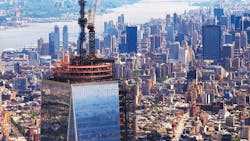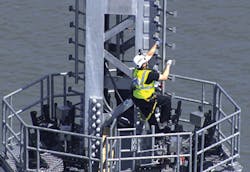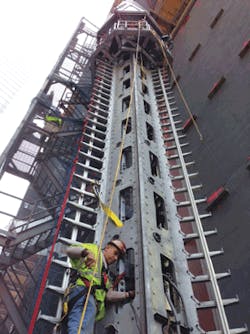One World Trade Center: Safe at 1,776 Feet
Rising an historic 1,776 feet, One World Trade Center in New York City not only is the tallest skyscraper in the Western Hemisphere but also is a symbol of American pride and resilience.
Designed by David Childs of Skidmore, Owings & Merrill, the 2.6 million-square-foot building includes office space, an observation deck, world-class restaurants and broadcast and antennae facilities. Once opened, thousands of people will work inside the building, but only a few highly skilled technicians will have access to the top of the building to maintain the communication equipment and lighting fixtures on the roof.
During the final stages of construction, project coordinators and building managers assessed the roof for fall hazards and the application of a fall protection system. The last major phase of construction for One World Trade Center involved using a crane to hoist a 408-foot, 758-ton spire into position.
Download a .pdf of this story, free with registration. Click here!
As the dozens of construction workers perched atop One World Trade Center looked on and applauded the historic milestone, crews installed the final two sections of the 408-foot steel spire on May 10.
"With the final section of spire now in place, One World Trade Center stands as the Western Hemisphere's tallest icon of freedom, resilience and the indomitable American spirit,” said Port Authority Vice Chairman Scott Rechler. "We could not have accomplished this momentous achievement without the thousands of men and women who have given so much over the years toward rebuilding the World Trade Center site. [This] milestone is a testament to the spirit of this great nation and a tribute to all who perished during the horrific attacks on 9/11."
Throughout the project, safety for the workers who entered the construction site was paramount. "Every day, thousands of construction workers from both sides of the Hudson come together to create a new, vibrant Lower Manhattan," said Port Authority Deputy Executive Director Bill Baroni as the spire was placed on the top of the building, adding that the completion of the building "symbolizes the ability of our nation to rebound and come back bigger and stronger than ever."
Hundreds, if not thousands, of hours of planning went on behind the scenes before the placement of those last segments of the spire. With the height of One World Trade Center, providing fall protection for the workers building the tower and installing the spire and for those who will be maintaining the communications equipment and lighting on the roof was a challenge.
When the spire was in the final stages of fabrication, DCM Erectors and theThe general consensus was that the system needed to provide continuous coverage to all work areas on and around the spire for a total of six workers simultaneously. The project coordinators decided that a rigid track system would be the best option. However, they needed a team of engineers who were capable of designing a system that completely was customized to their specifications. Rigid Lifelines was chosen to provide the fall protection system.
"We are immensely proud to be protecting America's workers and providing fall protection for the tallest building in the Western Hemisphere," said Arnold Timothy Galpin, engineering manager at Rigid Lifelines, who was the head of the design team for the entire system.
Designing a System
In order to install a fall protection system, a fall hazard analysis is a crucial first step. The analysis process helps fall protection professionals determine which system is best suited for the specific hazards at a work site. John Kemp, Rigid Lifelines' national product and sales manager, explains the importance of having several different staff members present during the planning phase of fall protection.
"Whenever you conduct any elevated work site analysis, you want all parties present who could be affected by any proposed solution(s)," says Kemp. "You need to make sure that you have all departments represented that have a stake in crafting the best solution for the application. Limiting input to perhaps only one department does not promote a team effort, which is critical for the acceptance and use of a system by the at-risk workers."
The fall hazards that maintenance crews face on top of One World Trade Center are not unique to that structure. Anyone who works on top of a skyscraper is exposed to certain hazards that could lead to an accidental loss of balance and potentially result in a fall. Lessons that were learned at One World Trade Center could serve to keep workers safe at other high-rise buildings.
They Don't Call Them Skyscrapers for Nothing
The altitude of skyscrapers exposes workers to hazards that may not seem obvious to the casual observer. One such hazard that contributes to falls for skyscraper crews is the weather. Since the weather can be unpredictable, it is best practice to encourage workers to use a fall protection system while accessing any area that is exposed to height.
Many maintenance managers will cancel roof work during thunderstorms or blizzards. Workers may need to access snow-, ice- or water-covered rooftops to perform emergency maintenance after a storm has passed. Whenever the elements are on a walking or working surface, workers have the potential to slip and fall. If there are particularly high winds, maintenance crews usually will not attempt to access the roof area. However, wind gusts can spring up while crews are working. In the event that workers experience such winds, it could cause an unintentional loss of balance and a potentially fatal fall.
Beyond adverse weather conditions, there are other challenges. Vertigo is a looming hazard for skyscraper maintenance and construction crews because of the height of the buildings where they work. Sometimes workers feel lightheaded or dizzy while working at extreme heights; those feelings can result in an unintentional loss of balance. The physical shape of the building can pose a hazard for workers as well. Rounded architectural styles and other modern construction can make a building more unique; but structures with slopes and uneven surfaces can disorient workers who are unfamiliar with working and traveling along those types of buildings.
When people are working above and below one another during skyscraper construction and maintenance, there is a chance for debris or tools to fall from one level to another. Workers easily can protect themselves from falling debris by wearing personal protective equipment, such as hard hats. By reducing the chances of head trauma, workers also will be at a reduced risk for being knocked unconscious and falling.
Another challenge during rooftop construction is that workers may be exposed to holes in walking surfaces. Even if a worker knows that a hole is at a job site, there still is a chance that he may forget and fall. Due to these hazard exposures, it is very important that workers who are doing maintenance or construction on the roof of a skyscraper utilize a fall protection system.
Fall Protection for an Iconic Building
In order to create a system design for One World Trade Center that could address these challenges, Rigid Lifelines communicated with DCM Erectors, the Port Authority of New York and New Jersey and Automated Steel Detailing Associates to perform a work site hazard analysis that answered six important questions:
➤ What does the supporting structure look like? What are the dimensions?
➤ How many workers need to be protected?
➤ What kind of mobility (horizontal vs. vertical) is required to perform the job?
➤ How can we provide an ergonomic and economically friendly solution to the specific geometry of the work path?
➤ If passive systems (guardrails, hole covers etc.) are not an option, will active systems (fall arrest) minimize total fall distance and swing fall issues?
➤ For active systems, is there a rescue plan for every work area?
By answering those questions, Rigid Lifelines was able to effectively design and manufacture a system that was ideal for One World Trade Center. Once Rigid understood the needs of the workers and the construction of the building, they began manufacturing 1,206 linear feet of horizontal track and 769 linear feet of vertical track for a combined total of 1,975 linear feet of rigid-track fall protection.
The horizontal fall protection system is on three stacked, circular platforms that surround the base of the spire. Workers will be able to navigate a full 64-foot radius on these platforms and access the communication antennas and devices on top of the building. The horizontal track uses standard eye-bolt rolling trolleys to provide workers with continuous fall protection.
The fall protection track on the top ring is slightly different from the other two. The top ring uses a side-pull trolley and limits the places that workers can travel. Since the top system limits a worker's access to a fall hazard, it is considered fall restraint. Workers connect to all three trolleys with set-length energy-absorbing lanyards. Despite having partially limited mobility, the platforms are wide enough and the lanyards are long enough that workers can access all areas where they need to work, but only have limited access to hazardous leading edges where they potentially could fall.
The vertical fall protection system is attached at the center of every ladder located along the spire. Workers access the spire ladder from inside the 104th floor. From there, they go through an overhead access hatch in the ceiling to travel to the outside ladder within the spire. As workers travel up the spire, they are able to access three different circular, grated platforms that will allow them to remain connected to the rigid track until they safely are behind a guardrail.
Workers disconnect from the vertical sections of track in order to access the gated platform areas. During this time, they use a dorsal-mounted self-retracting lanyard (SRL) for fall protection until they close the guardrail gate behind them. Workers reconnect to the next vertical section of track from behind the safety of the guardrails. From those platforms, the crew also accesses shorter sections of pole step ladders that take them to other antennas that need maintenance.
Once workers reach the third platform, they are at the base of the beacon light assembly. Workers need to access the beacon light to change the different LED light bulbs that illuminate the top of the spire for pilots. From the base of the beacon light, two workers simultaneously can connect to SRLs that serve as the fall protection system for inside the small space of the assembly. SRLs are being used in the assembly because the ladder is too narrow to support a vertical track system.
"Since the system has been installed, we have received very positive feedback from the workers who have used it," said Rigid Lifelines' Galpin.
Incorporating Fall Protection Into Design
Many urban buildings use the rooftop for utilitarian purposes, but a majority of those buildings have not incorporated a fall protection system into the structure for protecting maintenance crews. Even though safety engineers can design fall protection systems that are customized to a pre-existing structure, there are a growing number of safety professionals who want to see the design and installation of fall protection systems included in the planning and designing stages of the skyscraper construction process.
Matthew Gillen, deputy director for the National Institute for Occupational Safety and Health (NIOSH), Office of Construction Safety and Health, firmly believes in the power of protection through design. Gillen believes architects and safety professionals should be working together to unify a building with its fall protection equipment.
"Many architects are using the roof on a building more than they ever have before," Gillen says. "The space on a roof is becoming a huge amenity that has been largely overlooked by architects in the past. But now that people are accessing rooftop areas as a living space, architects are starting to incorporate fall prevention and protection into their designs."
Working with many different architects and construction companies, Gillen typically meets resistance when he suggests that fall protection be included in their designs. "The response I get from architectural firms can be pretty negative,” says Gillen. "Most architects are of the opinion that the ‘means and methods' for the safety of construction and maintenance personnel is the sole responsibility of the crew's manager."
Although disheartening, this is a fairly common attitude within the architectural community. Ultimately, fall protection and worker safety should be the responsibility of everyone involved with the work site. Employers sometimes forget one of the biggest benefits of having a fall protection system in the workplace: keeping workers productive. Because they are not fearful about the threat of life-threatening falls, workers are able to focus on doing their jobs.
Architects, engineers and project coordinators will find that it is easier to protect rooftop workers if they make safety part of their plan instead of an afterthought. Since DCM Erectors and the Port Authority of New York and New Jersey were proactive about incorporating a fall protection system into their construction process, they were able to maximize the effectiveness of the safety system that was installed for all maintenance workers and provide those workers with a life-saving fall protection system.
Download a .pdf of this story, free with registration. Click here!
(Additional reporting by Sandy Smith)
Hannah Addison is the marketing copywriter for Rigid Lifelines and the manager of the "Rigid Ramblings" fall protection blog. She graduated from Kutztown University with a B.A. in professional writing.


